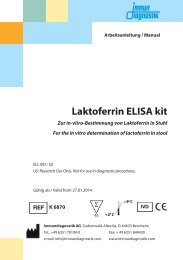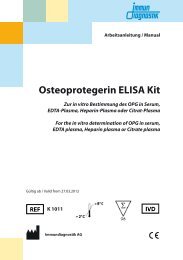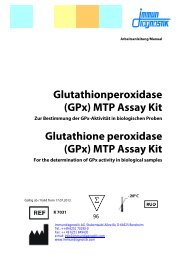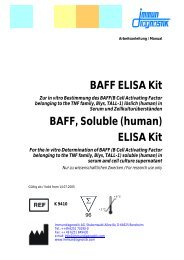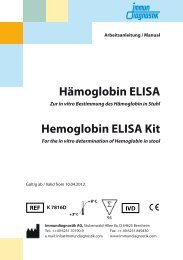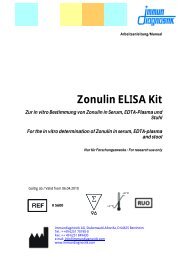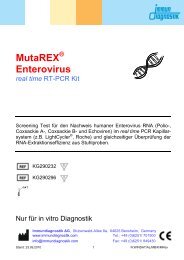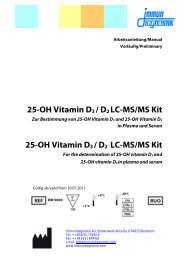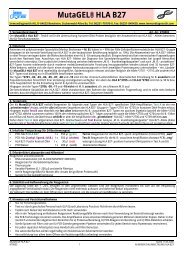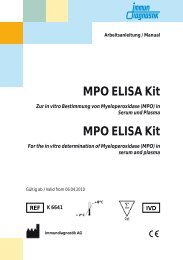Sie wollen auch ein ePaper? Erhöhen Sie die Reichweite Ihrer Titel.
YUMPU macht aus Druck-PDFs automatisch weboptimierte ePaper, die Google liebt.
+2 °C<br />
+8 °C<br />
Arbeitsanleitung/Manual<br />
1,<strong>25</strong>-(<strong>OH</strong>)2-<strong>Vitamin</strong> D <strong>ELISA</strong> <strong>Kit</strong><br />
Zur in vitro Bestimmung von 1,<strong>25</strong>-(<strong>OH</strong>)2-<strong>Vitamin</strong> D in Plasma und<br />
Serum<br />
For the in vitro determination of 1,<strong>25</strong>-(<strong>OH</strong>) vitamin D in plasma<br />
2<br />
and serum<br />
Gültig ab/valid from 24.06.2009<br />
K 2112<br />
48<br />
Immundiagnostik AG, Stubenwald-Allee 8a, D 646<strong>25</strong> Bensheim<br />
Tel.: ++49 6<strong>25</strong>1 70190-0<br />
Fax: ++ 49 6<strong>25</strong>1 849430<br />
e.mail: Info@immundiagnostik.com<br />
www.Immundiagnostik.com
Arbeitsanleitung/Manual 1,<strong>25</strong> (<strong>OH</strong>)2 <strong>Vitamin</strong> D<br />
Inhalt / Content<br />
1. Deutsch<br />
2. English<br />
Weitere Informationen zu unseren Produkten finden Sie auf unserer<br />
Homepage<br />
Additional information about our products is available on our homepage<br />
www.immundiagnostik.com
Arbeitsanleitung/Manual 1,<strong>25</strong> (<strong>OH</strong>)2 <strong>Vitamin</strong> D<br />
1. VERWENDUNGSZWECK<br />
Der hier beschriebene Enzyme-Linked-Immuno-Sorbent-Assay (<strong>ELISA</strong>) ist für<br />
die quantitative Bestimmung von 1,<strong>25</strong>-Dihydroxy-<strong>Vitamin</strong> D in Serum und<br />
Plasma geeignet. Nur zur in vitro Diagnostik.<br />
2. EINLEITUNG<br />
<strong>Vitamin</strong> D wird entweder in der Haut (unter Einfluss von UV-Licht) gebildet<br />
oder aus der Nahrung aufgenommen. In der Leber entsteht die<br />
Speicherform des <strong>Vitamin</strong> D, das <strong>25</strong>-Hydroxy-<strong>Vitamin</strong> D. In der Niere wird in<br />
einem 2. Hydroxylierungsschritt die Hormonform des <strong>Vitamin</strong> D, das 1,<strong>25</strong>-<br />
Dihydroxy-<strong>Vitamin</strong> D (D-Hormon) gebildet. Das dafür verantwortliche<br />
Enzym, die 1α-Hydroxylase der Niere, unterliegt einer strengen Kontrolle<br />
durch Hormone (insbesondere Parathormon) und wird in seiner Aktivität<br />
auch durch die Serumkonzentrationen von Calcium und Phosphat<br />
beeinflusst.<br />
Die Serumkonzentration von 1,<strong>25</strong>-Dihydroxy-<strong>Vitamin</strong> D richtet sich also<br />
normalerweise nach den Erfordernissen des Stoffwechsels. Abweichungen<br />
der 1,<strong>25</strong>-Dihydroxy-<strong>Vitamin</strong> D-Konzentration von der Norm müssen also<br />
immer im Kontext mit den übrigen Parametern des Calciumstoffwechsels<br />
interpretiert werden. Erst bei ausgeprägtem <strong>Vitamin</strong> D-Mangel wird auch die<br />
Serumkonzentration von 1,<strong>25</strong>-Dihydroxy-<strong>Vitamin</strong> D absinken. Zur<br />
Diagnostik des <strong>Vitamin</strong> D-Mangels sollte man deshalb den Vorläufermetabolit,<br />
das <strong>25</strong>-Hydroxy-<strong>Vitamin</strong> D messen. Ursachen für einen<br />
unphysiologischen Mangel an 1,<strong>25</strong>-Dihydroxy-<strong>Vitamin</strong> D können jedoch<br />
Metabolisierungsstörungen entweder aufgrund genetischer Defekte der 1α-<br />
Hydroxylase (selten) oder aufgrund von Nierenfunktionsstörungen<br />
(häufiger) auftreten. Bereits bei leicht eingeschränkter Nierenfunktion<br />
kommt es zu einem Abfall der 1,<strong>25</strong>-Dihydroxy-<strong>Vitamin</strong> D-Konzentration.<br />
Da 1,<strong>25</strong>-Dihydroxy-<strong>Vitamin</strong> D wichtige Funktionen im Calciumstoffwechsel<br />
hat und insbesondere auch die Parathormonsekretion in den Nebenschilddrüsen<br />
supprimiert, kommt es mit zunehmender Niereninsuffizienz zur<br />
Ausbildung der renalen Osteopathie, die durch Mineralisierungsstörungen<br />
(Osteomalazie) und fibröse Veränderungen (Osteitis fibrosa) gekennzeichnet<br />
ist.<br />
Die Behandlung der renalen Osteopathie besteht in der Gabe von 1,<strong>25</strong>-<br />
Dihydroxy-<strong>Vitamin</strong> D (Calcitriol) oder des Prohormons 1α-Hydroxy-<strong>Vitamin</strong><br />
D. Erniedrigte oder relativ niedrige 1,<strong>25</strong>-Dihydroxy-<strong>Vitamin</strong> D-Spiegel findet<br />
man bei renalen Tubulusfunktionsstörungen (z.B. Phosphatdiabetes,<br />
Fanconi-Syndrom). Eine unphysiologische Überproduktion von 1,<strong>25</strong>-<br />
Dihydroxy-<strong>Vitamin</strong> D tritt bei granulomatösen Systemerkrankungen (z.B.<br />
1
Arbeitsanleitung/Manual 1,<strong>25</strong> (<strong>OH</strong>)2 <strong>Vitamin</strong> D<br />
Sarkoidose) auf, wo eine extrarenale 1,<strong>25</strong>-Dihydroxy-<strong>Vitamin</strong> D Synthese<br />
stattfindet. Diese kann zur Hypercalciämie führen. Auch bei der<br />
idiopathischen Hypercalciurie findet man relativ hohe 1,<strong>25</strong>-Dihydroxy-<br />
<strong>Vitamin</strong> D-Spiegel. Erhöhte 1,<strong>25</strong>-Dihydroxy-<strong>Vitamin</strong> D-Konzentrationen<br />
wurden des Weiteren in folgenden Fällen ermittelt: bei Störungen des<br />
<strong>Vitamin</strong> D-Rezeptors (selten), bei calciumarmer Ernährung, sowie bei<br />
Parathormonüberschuß (primärer Hyperparathyreoidismus) und bei<br />
manchen Tumorarten (infolge Sekretion von parathormonähnlichem Peptid,<br />
PTHrP).<br />
Indikationen:<br />
• Nierenfunktionsstörungen<br />
Chronische Niereninsuffizienz<br />
Hämodialyse nach Nierentransplantation<br />
• Renale Osteopathie<br />
• Osteomalazie bei V.a. gestörten <strong>Vitamin</strong> D-Metabolismus<br />
• Nierentubulusfunktionsstörungen (Phosphatdiabetes, Fanconi-Syndrom)<br />
• Überwachung einer Therapie mit aktiven <strong>Vitamin</strong> D-Metaboliten<br />
• Ideopathische Hypercalciurie<br />
• Hypercalciämie<br />
2
Arbeitsanleitung/Manual 1,<strong>25</strong> (<strong>OH</strong>)2 <strong>Vitamin</strong> D<br />
3. INHALT DER TESTPACKUNG<br />
Artikel Nr. Inhalt <strong>Kit</strong> Komponenten Menge<br />
K 2112MTP PLATE Mikrotitermodul, vorbeschichtet 12 x 8<br />
Vertiefungen<br />
K 2112WP WASHBUF <strong>ELISA</strong> Waschpufferkonzentrat 10x 100 ml<br />
K 2112E ETHANOL Ethanol, gebrauchsfertig 1.5 ml<br />
K 2112TP TRIS-HCL Tris-HCL Puffer, gebrauchsfertig 30 ml<br />
K 2112A1 AB Detektionsantikörper,<br />
anti-1,<strong>25</strong>-(<strong>OH</strong>)2-<strong>Vitamin</strong> D,<br />
gebrauchsfertig<br />
K 2112ST STD Standard incl. NSB, gebrauchsfertig<br />
(Bereich siehe Spezifikation oder<br />
Etikett)<br />
K 2112KO CTRL Kontrollen, gebrauchsfertig<br />
(Bereich der Spezifikation entnehmen)<br />
K 2112K CONJ Konjugat, polyklonaler peroxidasemarkierter<br />
Antikörper,<br />
gebrauchsfertig<br />
K 2112TMB SUB TMB Substrat (Tetramethylbenzidin),<br />
gebrauchsfertig<br />
3<br />
<strong>25</strong> ml<br />
7 x 2.5 ml<br />
2 x 2.5 ml<br />
22 ml<br />
2 x 15 ml<br />
K 2112AC STOP <strong>ELISA</strong> Stopplösung, gebrauchsfertig 15 ml
Arbeitsanleitung/Manual 1,<strong>25</strong> (<strong>OH</strong>)2 <strong>Vitamin</strong> D<br />
4. ERFORDERLICHE LABORGERÄTE UND HILFSMITTEL<br />
• Bidestilliertes Wasser (aqua bidest.)<br />
• 48 Chromabond Säulen (Artikelnr.: Se2112)<br />
• 48 Silica Kartuschen (Festphasen-Extraktionskartuschen,<br />
Artikelnr.: Sb2221)<br />
• Diisopropylether (p.A.) 99.0 %<br />
• Isopropanol (p.A) 99.9 %<br />
• n-Hexan (p.A.) 98.3 %<br />
• Methanol (p.A.) 99.9 %<br />
• 75 x 12 Reagenzgefäße aus Glas (kein Plastik)<br />
• Extraktionsständereinheit (Artikelnr.: K2221sv)<br />
• Präzisionspipetten und Einmalpipettenspitzen mit variablen Volumina<br />
von 10 - 1000 µl<br />
• Folie zum Abkleben der Mikrotiterplatte<br />
• Mikrotiterplattenschüttler<br />
• Multikanal- bzw. Multipipette<br />
• Zentrifuge, 3000 x g<br />
• Vortex-Mixer<br />
• Vakuumzentrifuge oder Stickstoffverteiler<br />
• Laborübliche Plastikröhrchen (Einmalartikel)<br />
• Mikrotiterplattenphotometer mit Filter 450 nm<br />
(Referenzfilter 620 oder 690 nm)<br />
4
Arbeitsanleitung/Manual 1,<strong>25</strong> (<strong>OH</strong>)2 <strong>Vitamin</strong> D<br />
5. VORBEREITUNG UND LAGERUNG DER REAGENZIEN<br />
• Bitte achten Sie bei mehrfachem Einsatz der Platte darauf, dass die<br />
Reagenzien, wie in der Vorschrift beschrieben, gelagert und nur die für<br />
den jeweiligen Ansatz benötigten Reagenzienmengen frisch<br />
angesetzt werden. Der <strong>Kit</strong> kann so bis zu 2 x je nach Probenaufkommen<br />
bis zum angegebenen Haltbarkeitsdatum verwendet werden.<br />
• Das Waschpufferkonzentrat (WASHBUF) muss vor Gebrauch 1:10 in<br />
bidestilliertem Wasser (aqua bidest.) verdünnt werden (100 ml Konzentrat<br />
+ 900 ml aqua bidest.), gut mischen. Aufgrund der hohen<br />
Salzkonzentration in den Stammlösungen kann es zu Kristallbildungen<br />
kommen. Die Kristalle lösen sich bei Raumtemperatur bzw. im<br />
Wasserbad bei 37 °C auf. Das Pufferkonzentrat kann bei 2-8°C bis zum<br />
angegebenen Haltbarkeitsdatum aufbewahrt werden. Die verdünnte<br />
Pufferlösung ist bei 2-8 °C einen Monat in einem geschlossenen Gefäß<br />
haltbar.<br />
• Alle anderen Testreagenzien sind bei 2-8 °C zu lagern und bei<br />
entsprechender Lagerung bis zum angegebenen Verfallsdatum (siehe<br />
Etikett) verwendbar.<br />
5
Arbeitsanleitung/Manual 1,<strong>25</strong> (<strong>OH</strong>)2 <strong>Vitamin</strong> D<br />
6. PROBENVORBEREITUNG<br />
Plasma/Serum Proben<br />
Frisch abgenommenes Blut sollte innerhalb einer Stunde abzentrifugiert<br />
werden. <strong>Vitamin</strong> D ist eine stabile Substanz; die Proben können deshalb in<br />
der Regel bei Raumtemperatur gelagert werden. Wir empfehlen aber, das<br />
Serum bei 2-8 °C zu lagern. Sollte innerhalb von 24 Stunden keine Messung<br />
erfolgen, empfiehlt es sich, die Proben bei –20 °C einzufrieren. Ein<br />
mehrfaches Einfrieren und Auftauen der Proben ist unter allen Umständen<br />
zu vermeiden.<br />
Die Serumproben können bei 4-8 °C (z.B. mit Coolpacks) transportiert<br />
werden und sind so bis zu 3 Tage haltbar.<br />
Lipämische oder hämolysierte Proben können zu fehlerhaften Ergebnissen<br />
führen. Vor dem Einsatz im Test sollten die Proben gut gemischt werden. Wir<br />
empfehlen alle Proben in Doppelbestimmungen zu analysieren.<br />
Wir empfehlen ein Probenvolumen von 1000 µl. Das Probenvolumen sollte<br />
jedoch nicht kleiner als 500 µl gewählt werden (Kapazität der Säulen ist<br />
1000 µl). Wird ein Probenvolumen von 500 µl gewählt, muss die Säule mit<br />
500 µl Tris-HCL vorgepuffert werden. Das Ergebnis wird mit dem<br />
entsprechenden Verdünnungsfaktor multipliziert um die tatsächliche<br />
Konzentration zu ermitteln.<br />
6
Arbeitsanleitung/Manual 1,<strong>25</strong> (<strong>OH</strong>)2 <strong>Vitamin</strong> D<br />
Extraktion der Proben<br />
1. Säule<br />
2.Säule<br />
7<br />
Glasröhrchen<br />
• Der Extraktionsständer besteht aus 3 Plexiglas-Untereinheiten, die<br />
übereinander gestellt werden.<br />
• In den oberen Teil werden die Chromabond-Säulen (Ständereinheit I) und<br />
in den unteren Teil (Ständereinheit II) die Silica Kartuschen (regenerierbar)<br />
eingesetzt.<br />
• Für die Extraktion und das Waschen wird die Extraktionseinheit (I und II) in<br />
eine Auffangschale gestellt. Nach dem Extraktionsschritt (Ether) werden die<br />
Chromabond-Säulen entfernt (Ständereinheit I).<br />
• Für den Elutionsschritt wird die Ständereinheit III mit den Reagenzgläsern<br />
(kein Plastik) unter die Ständereinheit II gestellt.
Arbeitsanleitung/Manual 1,<strong>25</strong> (<strong>OH</strong>)2 <strong>Vitamin</strong> D<br />
7. TESTDURCHFÜHRUNG<br />
Testprinzip<br />
Der Test basiert auf einer kompetetiven Enzyme-Immuno-Assay (EIA)<br />
Technik. Es wird ein ausgewählter monoklonaler Antikörper, der 1,<strong>25</strong>-<br />
Dihydroxy-<strong>Vitamin</strong> D erkennt, verwendet.<br />
Standards, NSB (nicht spezifische Bindung), Kontrollen und Patientenseren,<br />
die auf 1,<strong>25</strong>-Dihydroxy-<strong>Vitamin</strong> D zu untersuchen sind, werden nach dem<br />
Extraktionsschritt mit dem Detektionsantikörper versetzt. In einer<br />
Vorinkubation bindet das 1,<strong>25</strong>-Dihydroxy-<strong>Vitamin</strong> D an den Antikörper. Das<br />
Vorinkubat wird in die Vertiefungen einer Mikrotiterplatte pipettiert, welche<br />
mit 1,<strong>25</strong>-Dihydroxy-<strong>Vitamin</strong> D beschichtet wurden. In diesem ersten<br />
Inkubationsschritt kompetitiert das 1,<strong>25</strong>-Dihydroxy-<strong>Vitamin</strong> D aus der Probe<br />
mit dem auf der Platte gekoppeltem 1,<strong>25</strong>-Dihydroxy-<strong>Vitamin</strong> D um die<br />
Bindungsstelle am Detektionsantikörper. Dann wird das Konjugat (ein<br />
Peroxidase markierter anti-Maus Antikörper) zugegeben und es bildet sich<br />
folgender Komplex an der Wand der Mikrotiterplatte: 1,<strong>25</strong>-Dihydroxy-<br />
<strong>Vitamin</strong> D - Detektionsantikörper – Peroxidase-Konjugat. Als Peroxidasesubstrat<br />
wird Tetramethylbenzidin (TMB) eingesetzt. Die Enzymreaktion<br />
wird durch Zugabe von Säure abgestoppt, wobei ein Farbumschlag von blau<br />
nach gelb erfolgt. Die entstandene chromogene Verbindung wird<br />
photometrisch bei 450 nm gemessen. Die Intensität der Farbe ist dem 1,<strong>25</strong>-<br />
Dihydroxy-<strong>Vitamin</strong> D-Gehalt umgekehrt proportional. Parallel dazu wird<br />
eine Standardkurve – Optische Dichte (Absorption bei 450 nm) versus<br />
Standardkonzentration - erstellt, aus der die Konzentrationen der Proben<br />
ermittelt werden.<br />
8
Arbeitsanleitung/Manual 1,<strong>25</strong> (<strong>OH</strong>)2 <strong>Vitamin</strong> D<br />
Extraktion<br />
1. 1000 µl Standards, Kontrollen, NSB bzw. Proben in Einzelwerten auf die<br />
Chromabond auftragen und 10 min. einziehen lassen. Bei Probenvolumena<br />
< 1000 µl werden die Säulen mit Tris-HCl vorgepuffert, z.B. 500<br />
µl Tris-HCl Puffer auf die Säule geben + 500 µl Probe<br />
2. Mit 4 x 1 ml Diisopropylether in je 3 min. Abstand das 1,<strong>25</strong>-Dihydroxy-<br />
<strong>Vitamin</strong> D von den Chromabond-Säulen direkt in die Silica-Kartuschen<br />
extrahieren. Nach der Extraktion müssen die Chromabond Säulen<br />
entfernt werden (Ständereinheit I)<br />
3. Mit 5 x 2 ml Isopropanol/Hexan (4/96 v/v) die Silica-Säulen waschen<br />
(Ständereinheit II)<br />
4. Mit 3 x 2 ml Isopropanol/Hexan (6/94) die Silica-Säulen waschen<br />
(Ständereinheit II)<br />
5. Die Elution des 1,<strong>25</strong>-Dihydroxy-<strong>Vitamin</strong> D erfolgt mit 2 x 2 ml<br />
Isopropanol/Hexan (<strong>25</strong>/75 v/v). Hinweis: Es ist darauf zu achten, dass<br />
die Reagenzgläser (kein Plastik) (Ständereinheit III) exakt unter den<br />
Säulen stehen<br />
6. Die eluierten Proben werden unter leichtem Stickstoffstrom bei 37 °C<br />
oder in einer Vakuumzentrifuge eingetrocknet<br />
Vorinkubation<br />
1. 20 µl Ethanol zu jeder eingetrockneten Probe bzw. jedem Standard, NSB<br />
und Kontrollen pipettieren und nach der Ethanol Zugabe vorsichtig<br />
vortexen.<br />
2. 450 µl Antikörperlösung zu den Proben, Standards, NSB und Kontrollen<br />
pipettieren und gut vortexen. Die Antikörperlösung ist viskos, daher<br />
langsam pipettieren.<br />
3. Genau 1 Stunde bei Raumtemperatur inkubieren.<br />
9
Arbeitsanleitung/Manual 1,<strong>25</strong> (<strong>OH</strong>)2 <strong>Vitamin</strong> D<br />
Pipettierschema<br />
Im Test dürfen nur Reagenzien und Proben verwendet werden, die<br />
Raumtemperatur (18-26°C) aufweisen. Vor Gebrauch Reagenzien und<br />
Proben gut mischen<br />
Die Positionen für STD/NSB/SAMPLE/CTRL (Standard/nicht spezifische<br />
Bindung/Probe/Kontrolle) im Protokollblatt markieren<br />
Die benötigten Mikrotiterstreifen aus dem <strong>Kit</strong> nehmen. Nicht verwendete<br />
Mikrotiterstreifen können abgeklebt bis zum angegebenen<br />
Haltbarkeitsdatum bei 2-8 °C gelagert werden<br />
200 µl STD/NSB/SAMPLE/CTRL in Doppelbestimmung in die<br />
Mikrotiterstreifen pipettieren. Das Vorinkubat ist eine viskose Flüssigkeit. Wir<br />
empfehlen daher die Pipettenspitze vorzuspülen und langsam zu<br />
pipettieren<br />
Streifen abdecken und 18-22 Stunden bei 6 - 10 °C inkubieren*<br />
Inhalt der Vertiefungen verwerfen und 5x mit je <strong>25</strong>0 µl verdünntem<br />
WASHBUF (Waschpuffer) waschen. Nach dem letzten Waschschritt Reste von<br />
Waschpuffer durch Ausklopfen auf saugfähigem Papier entfernen<br />
200 µl CONJ (Konjugat) in alle Vertiefungen pipettieren<br />
Streifen abdecken und genau 1 Stunde bei Raumtemperatur (18-26°C) unter<br />
Schütteln inkubieren<br />
10
Arbeitsanleitung/Manual 1,<strong>25</strong> (<strong>OH</strong>)2 <strong>Vitamin</strong> D<br />
Inhalt der Vertiefungen verwerfen und 5x mit je <strong>25</strong>0 µl verdünntem<br />
WASHBUF (Waschpuffer) waschen. Nach dem letzten Waschschritt Reste von<br />
Waschpuffer durch Ausklopfen auf saugfähigem Papier entfernen<br />
200 µl SUB (Substrat) in alle Vertiefungen pipettieren<br />
20 - 30 Minuten bei Raumtemperatur (18-26°C) im Dunkeln inkubieren**<br />
50 µl STOP (Stopplösung) in alle Vertiefungen pipettieren, gut mischen<br />
Extinktion sofort im Mikrotiterplattenphotometer bei 450 nm gegen die<br />
Referenzwellenlänge 620 nm (oder 690 nm) messen. Ist keine<br />
Referenzwellenlänge vorhanden, wird nur bei 450 nm gelesen. Falls die<br />
Extinktion des höchsten Standards den Messbereich des Photometers<br />
übersteigt, sollte sofort bei 405 nm gegen 620 nm (690 nm) gemessen<br />
werden<br />
*Bei kompetetiven Assays ist darauf zu achten, dass die Inkubation immer unter konstanten Bedingungen<br />
(Temperatur, Dauer) erfolgt. Das trifft im Speziellen bei der über Nacht Inkubation zu. Wir empfehlen<br />
immer die gleiche Zeitspanne (z. B. 20 h) für die Inkubation.<br />
**Die Intensität der Farbentwicklung ist temperaturabhängig. Es wird empfohlen den Farbumschlag<br />
während der Inkubationszeit zu beobachten und entsprechend der Farbentwicklung die Reaktion zu<br />
stoppen.<br />
11
Arbeitsanleitung/Manual 1,<strong>25</strong> (<strong>OH</strong>)2 <strong>Vitamin</strong> D<br />
8. ERGEBNISSE<br />
Die unten beschriebenen mathematischen Modelle können alternativ zur<br />
Auswertung benutzt werden. Wir empfehlen die 4-Parameter Funktion:<br />
1. 4-Parameter-Funktion<br />
Für die optische Dichte empfehlen wir eine lineare Ordinate und für<br />
die Konzentration eine logarithmische Abszisse (bei einer<br />
logarithmischen Abszisse muss für den Standard mit der<br />
Konzentration 0 ein Wert kleiner 1 eingegeben werden z. B. 0.01).<br />
2. Punkt-zu-Punkt-Auswertung<br />
Für die optische Dichte und für die Konzentration empfehlen wir eine<br />
lineare Ordinate bzw. Abszisse.<br />
3. Gewichtete Spline-Funktion<br />
Für die optische Dichte empfehlen wir eine lineare Ordinate und für<br />
die Konzentration eine logarithmische Abszisse (bei einer<br />
logarithmischen Abszisse muss für den Standard mit der<br />
Konzentration 0 ein Wert kleiner 1 eingegeben werden z. B. 0.01).<br />
Vor jeder automatischen Auswertung sollte stets eine Kontrolle der<br />
Doppelwerte auf Plausibilität („Ausreißerkontrolle“) durchgeführt<br />
werden; falls dies nicht durch das verwendete Programm erfolgt,<br />
sollte die Kontrolle manuell durchgeführt werden.<br />
9. EINSCHRÄNKUNGEN<br />
Proben mit einer 1,<strong>25</strong>-Dihydroxy-<strong>Vitamin</strong> D-Konzentration größer als der<br />
höchste Standard sollten mit weniger Probenmaterial (z.B. 750 µl oder 500<br />
µl) auf die vorgepufferte Säule aufgetragen und nochmals im Assay<br />
gemessen werden. Die Proben werden mit dem entsprechenden<br />
Verdünnungsfaktor multipliziert.<br />
12
Arbeitsanleitung/Manual 1,<strong>25</strong> (<strong>OH</strong>)2 <strong>Vitamin</strong> D<br />
10. QUALITÄTSKONTROLLE<br />
Immundiagnostik AG empfiehlt den Einsatz von kommerziell erhältlichen<br />
Kontrollen (wenn vorhanden) für die interne Qualitätskontrolle.<br />
Wir empfehlen die Kontrollen bei jedem Testansatz mitzumessen. Die<br />
Ergebnisse der Kontrollen müssen auf Richtigkeit überprüft werden. Liegen<br />
einer oder mehrere Werte außerhalb des angegebenen Bereiches, kann<br />
Immundiagnostik AG die Richtigkeit der Werte nicht gewährleisten.<br />
Erwartete Ergebnisse<br />
Normbereich (Plasma oder Serum):<br />
Gesunde Erwachsene 20-50 Jahre: 17 - 53 pg/ml<br />
Kinder bis 12 Jahre: bis zu 40% höhere Werte<br />
Schwangere (8.-42. Gestationswoche): bis zu 60% höhere Werte<br />
Personen über 70 Jahre: bis zu 40% niedrigere Werte<br />
Es treten keine jahreszeitlichen Schwankungen auf.<br />
Wir empfehlen jedem Labor einen eigenen Normwertbereich zu etablieren.<br />
13
Arbeitsanleitung/Manual 1,<strong>25</strong> (<strong>OH</strong>)2 <strong>Vitamin</strong> D<br />
11. TESTCHARAKTERISTIKA<br />
Präzision und Reproduzierbarkeit<br />
Intra-Assay (n=20)<br />
Probe<br />
1,<strong>25</strong> (<strong>OH</strong>)2 <strong>Vitamin</strong> D<br />
[pg/ml]<br />
14<br />
VK<br />
[%]<br />
1 55.3 6.69<br />
Inter-Assay (n=20)<br />
Probe<br />
1,<strong>25</strong> (<strong>OH</strong>)2 <strong>Vitamin</strong> D<br />
[pg/ml]<br />
VK<br />
[%]<br />
1 39 9<br />
Sensitivität<br />
Die Nachweisgrenze wurde festgelegt als B0 + 2 SD. Gemessen wurde 20 mal<br />
der Standard null.<br />
Probe<br />
1,<strong>25</strong> (<strong>OH</strong>)2 <strong>Vitamin</strong> D<br />
Mittelwert<br />
[OD]<br />
Standardabweichung<br />
(SD)<br />
Nachweisgrenze<br />
[pg/ml]<br />
1 1.201 0.0<strong>25</strong> 4.8<br />
Kreuzreaktivität<br />
1,<strong>25</strong>-(<strong>OH</strong>)2 Vit D3 100 %<br />
1,<strong>25</strong>-(<strong>OH</strong>)2 Vit D2 41 %<br />
Vit D2 & D3 < 0.01 %<br />
24,<strong>25</strong>-(<strong>OH</strong>)2 Vit D3 < 0.1 %<br />
<strong>25</strong>-<strong>OH</strong> Vit D2 < 0.1 %<br />
<strong>25</strong>-<strong>OH</strong> Vit D3 < 0.01 %<br />
Alfacalcidol < 0.003 %
Arbeitsanleitung/Manual 1,<strong>25</strong> (<strong>OH</strong>)2 <strong>Vitamin</strong> D<br />
Linearität<br />
Unterschiedliche Verdünnungen von zwei Patientenproben wurden im Test<br />
gemessen. Die Ergebnisse sind in der unten stehenden Tabelle aufgeführt.<br />
n= 2<br />
Probe<br />
A<br />
Verdünnung Erwartet<br />
[pg/ml]<br />
B<br />
15<br />
Gemessen<br />
[pg/ml]<br />
1000 21.2 21.2<br />
750 15.9 15.9<br />
500 10.6 11.2<br />
<strong>25</strong>0 5.3 8.5<br />
1000 29.6 29.6<br />
750 22.2 27.3<br />
500 14.8 16.9<br />
<strong>25</strong>0 7.4 7.2<br />
12. REGENERIERUNG DER SILICA-KARTUSCHEN<br />
Die Silica-Kartuschen (untere Säulen) werden nach folgendem Schema<br />
regeneriert. Die Säulen können direkt nach der Extraktion regeneriert werden<br />
und müssen vor dem nächsten Gebrauch trocken sein. Bis zu 5<br />
Regenerierungszyklen sind möglich.<br />
• 2 x 2 ml Methanol auftragen.<br />
• 2 x 2 ml n-Hexan auftragen.<br />
• Säulen danach unter dem Abzug trocknen lassen.
Arbeitsanleitung/Manual 1,<strong>25</strong> (<strong>OH</strong>)2 <strong>Vitamin</strong> D<br />
13. VORSICHTSMAßNAHMEN<br />
• Nur zur in vitro Diagnostik.<br />
• Qualitätskontrollen sollten immer mit gemessen werden.<br />
• Das für <strong>Kit</strong>komponenten verwendete humane Material wurde auf HIV,<br />
Hepatitis B und Hepatitis C getestet und für negativ befundet. Dennoch<br />
wird empfohlen, die <strong>Kit</strong>komponenten als Vorsichtsmaßnahme immer<br />
wie potentiell infektiöses Material zu behandeln.<br />
• Die <strong>Kit</strong>komponenten enthalten zum Schutz vor bakteriellen<br />
Kontaminationen Natriumazid oder Thimerosal. Natriumazid bzw.<br />
Thimerosal sind giftig. Auch Substrate für enzymatische Farbreaktionen<br />
sind giftig und karzinogen. Jeder Kontakt mit Haut oder Schleimhaut ist<br />
zu vermeiden.<br />
• Die Stopplösung besteht aus verdünnter Schwefelsäure (H2SO4). H2SO4<br />
ist eine starke Säure und muss auch in verdünnter Form mit Vorsicht<br />
verwendet werden. H2SO4 verursacht bei Kontakt mit der Haut<br />
Verätzungen. Es sollte daher mit Schutzhandschuhen, Schutzkleidung<br />
und Schutzbrille gearbeitet werden. Bei Kontakt mit der Säure muss die<br />
verätzte Stelle sofort mit viel Wasser gespült werden.<br />
14. TECHNISCHE MERKMALE<br />
• Reagenzien der <strong>Kit</strong>packung dürfen nicht mit anderen Chargen gemischt<br />
werden.<br />
• Die Reagenzien dürfen nach Ablauf des Mindesthaltbarkeitsdatums<br />
nicht mehr verwendet werden.<br />
• Substratlösung muss vor Gebrauch farblos sein.<br />
• Mikrotiterstreifen müssen während den Inkubationen mit Folie<br />
abgedeckt sein.<br />
• Schaumbildung beim Mischen der Reagenzien soll vermieden werden.<br />
• Die Bestimmung ist immer nach der im <strong>Kit</strong> beigefügten<br />
Arbeitsanleitung durchzuführen.<br />
16
Arbeitsanleitung/Manual 1,<strong>25</strong> (<strong>OH</strong>)2 <strong>Vitamin</strong> D<br />
15. ALLGEMEINE HINWEISE ZUM TEST<br />
• Dieser <strong>Kit</strong> wurde nach der IVD Richtlinie 98/79/EG hergestellt und in den<br />
Verkehr gebracht.<br />
• Alle im <strong>Kit</strong> enthaltenen Reagenzien dürfen ausschließlich zur in vitro<br />
Diagnostik verwendet werden.<br />
• Für die Qualitätskontrolle sind die für medizinische Laboratorien<br />
erstellten Richtlinien zu beachten.<br />
• Die Testcharakteristika wie Inkubationszeiten, Inkubationstemperaturen<br />
und Pipettiervolumina der verschiedenen Komponenten wurden vom<br />
Hersteller festgelegt. Nicht mit dem Hersteller abgesprochene<br />
Veränderungen in der Testdurchführung können die Resultate<br />
beeinflussen. Die Firma Immundiagnostik AG übernimmt für die<br />
hierdurch entstandenen Schäden und Folgeschäden keine Haftung.<br />
• Bei Gewährleistungsansprüchen ist das beanstandete Material mit<br />
schriftlicher Erklärung innerhalb von 14 Tagen zum Hersteller, der<br />
Immundiagnostik AG, zurück zu senden.<br />
16. LITERATUR<br />
1. Wildermuth S. et al., 1993; Clinica chimica Acta, 220, 61<br />
2. Schilling M. et al., 1987; Clinical Chemistry, 33, 187<br />
3. Armbruster F.P. et al., 1990; Ärztl. Lab., 36, 75<br />
4. Durham B.W. et al., 1995; Ann. Clin. Biochem., 32, 77<br />
5. Hollis B.W., 1996; Calcif. Tissue Int., 58, 4<br />
6. Hollis B.W.,1995; Clinical Chemistry, 41, 1313<br />
7. Iqbal S.J. et al., 1996; Clinical Chemistry, 42, 112<br />
8. Withold W. et al., 1995; Eur. J. Clin. Chem. Clin. Biochem., 33, 15<br />
<strong>25</strong>.06.2009 021220041<strong>25</strong><strong>OH</strong>vitD.doc<br />
17
Arbeitsanleitung/Manual 1,<strong>25</strong> (<strong>OH</strong>)2 <strong>Vitamin</strong> D<br />
18
Arbeitsanleitung/Manual 1,<strong>25</strong> (<strong>OH</strong>)2 <strong>Vitamin</strong> D<br />
1,<strong>25</strong> (<strong>OH</strong>)2 <strong>Vitamin</strong> D <strong>ELISA</strong> <strong>Kit</strong><br />
For the in vitro determination of 1,<strong>25</strong>-(<strong>OH</strong>) 2 vitamin D in plasma<br />
and serum<br />
Valid from 24.06.2009<br />
K 2112<br />
48<br />
19<br />
+2 °C<br />
+8 °C
Arbeitsanleitung/Manual 1,<strong>25</strong> (<strong>OH</strong>)2 <strong>Vitamin</strong> D<br />
1. INTENDED USE<br />
The described Enzyme-Linked-Immuno-Sorbent-Assay (<strong>ELISA</strong>) is intended<br />
for the quantitative determination of 1,<strong>25</strong>-dihydroxy vitamin D in serum and<br />
plasma. It is for in vitro diagnostic use only.<br />
2. INTRODUCTION<br />
<strong>Vitamin</strong> D is either produced in the skin (under the influence of UV light) or<br />
taken up from nourishment. The storage type of vitamin D, namely <strong>25</strong>hydroxy<br />
vitamin D, is formed in the liver. The hormone 1,<strong>25</strong>-dihydroxy<br />
vitamin D (D hormone) is formed in a second hydroxylation step in the<br />
kidney. The responsible enzyme, the kidney 1α-hydroxylase, is subjected to<br />
a rigid control through hormones (especially parathyroid hormone) and its<br />
activity is influenced by the serum concentrations of calcium and phosphate.<br />
The serum concentration of 1,<strong>25</strong>-dihydroxy vitamin D normally re-adjusts<br />
itself to the demands of metabolism. Deviations from the normal range of<br />
1,<strong>25</strong>-dihydroxy vitamin D must therefore always be interpreted in the<br />
context of the remaining parameters of the calcium metabolism. The serum<br />
concentration of 1,<strong>25</strong>-dihydroxy vitamin D decreases only in seldom cases of<br />
vitamin D deficiency. For the diagnosis of vitamin D deficiency the precursor<br />
metabolite, <strong>25</strong>-hydroxyvitamin D, should be measured.<br />
The reason for a non-physiological deficiency of 1,<strong>25</strong>-dihydroxy vitamin D<br />
can be found in metabolic disturbances, caused either by genetic defects of<br />
the enzyme 1α-hydroxylase (rare) or kidney malfunctions (more common).<br />
Even a slightly impaired kidney function can lead to a decrease of the 1,<strong>25</strong>dihydroxy<br />
vitamin D concentration.<br />
Since 1,<strong>25</strong>-dihydroxy vitamin D has important functions in calcium<br />
metabolism as well as supplementing secretion of parathyroid hormone<br />
from the parathyroid glands, increasing kidney malfunctioning leads to<br />
development of renal osteopathy, which is characterized by osteomalacia<br />
and osteitis fibrosa.<br />
Treatment of renal osteopathy consists of the administration of 1,<strong>25</strong>dihydroxy<br />
vitamin D (calcitriol) or the prohormone 1α-hydroxy vitamin D. In<br />
renal tubules malfunctions decreased or relatively low levels of 1,<strong>25</strong>dihydroxy<br />
vitamin D (e.g. diabetes insipidus, Fanconi-syndrom) are found. A<br />
non-physiological over-production of 1,<strong>25</strong>-dihydroxy vitamin D arises in<br />
granulomatosis (e.g. sarcoidosis), where extra-renal synthesis of 1,<strong>25</strong>dihydroxy<br />
vitamin D occurs. This can lead to hypercalcaemia. Also in<br />
idiopathic hypercalciuria a relatively high level of 1,<strong>25</strong>-dihydroxy vitamin D is<br />
found. Increased concentrations of 1,<strong>25</strong>-dihydroxy vitamin D can be seen in<br />
case of non-functional vitamin D receptors (rare), during calcium deficient<br />
20
Arbeitsanleitung/Manual 1,<strong>25</strong> (<strong>OH</strong>)2 <strong>Vitamin</strong> D<br />
nutrition, as well as a result from overproduction of parathyroid hormone<br />
(primary hyperthyroidism).<br />
Indications<br />
• Defect of kidney functions<br />
Chronic kidney failure<br />
Haemodialysis following kidney transplantation<br />
• Renal osteopathy<br />
• Osteomalacia from various types of vitamin D metabolism disturbances<br />
• Kidney tubules function disturbances (diabetes insipidus, Fanconi-<br />
Syndrom)<br />
• Monitoring of therapy with active vitamin D metabolites<br />
• Ideopathic hypercalciuria<br />
• Hypercalcaemia<br />
21
Arbeitsanleitung/Manual 1,<strong>25</strong> (<strong>OH</strong>)2 <strong>Vitamin</strong> D<br />
3 MATERIAL SUPPLIED<br />
Catalogue No Content <strong>Kit</strong> Components Quantity<br />
K 2112MTP PLATE One holder with precoated strips 12 x 8 wells<br />
K 2112WP WASHBUF <strong>ELISA</strong> wash buffer concentrate 10x 100 ml<br />
K 2112E ETHANOL Ethanol, ready-to-use 1.5 ml<br />
K 2112TP TRIS-HCL Tris-HCL buffer, ready-to-use 30 ml<br />
K 2112A1 AB Detection antibody,<br />
anti 1,<strong>25</strong>-(<strong>OH</strong>)2 vitamin D,<br />
ready-to-use<br />
K 2112ST STD Standard incl. NSB, ready-to-use<br />
(for range see specification or label)<br />
K 2112KO CTRL Controls, ready-to-use<br />
(for range see specification)<br />
K 2112K CONJ Conjugate, polyclonal peroxidaselabeled<br />
antibody, ready-to-use<br />
K 2112TMB SUB TMB substrate<br />
(Tetramethylbenzidine), ready-to-use<br />
22<br />
<strong>25</strong> ml<br />
7 x 2.5 ml<br />
2 x 2.5 ml<br />
22 ml<br />
2 x 15 ml<br />
K 2112AC STOP <strong>ELISA</strong> stop solution, ready-to-use 15 ml
Arbeitsanleitung/Manual 1,<strong>25</strong> (<strong>OH</strong>)2 <strong>Vitamin</strong> D<br />
4 MATERIAL REQUIRED BUT NOT SUPPLIED<br />
• Bidistilled water (aqua bidest.)<br />
• 48 Chromabond columns (Catalog No.: Se2112)<br />
• 48 Silica Cartridges (solid phase extraction cartridges,<br />
Catalog No.: Sb2221)<br />
• Diisopropylether (p.A.) 99.0 %<br />
• Isopropanol (p.A) 99.9 %<br />
• n-Hexan (p.A.) 98.3 %<br />
• Methanol (p.A.) 99.9 %<br />
• 75 x 12 glass tubes (no plastic)<br />
• Extraction rack (Catalog No.: K2221sv)<br />
• Precision pipettors and disposable tips to deliver 10-1000 µl<br />
• Foil to cover the microtiter plate<br />
• Horizontal microtiter plate shaker<br />
• A multi-channel dispenser or repeating dispenser<br />
• Centrifuge capable of 3000 x g<br />
• Vortex-Mixer<br />
• Vacuum centrifuge or nitrogen distributor<br />
• Standard laboratory glass or plastic vials, cups, etc.<br />
• Microtiter plate reader at 450 nm<br />
(reference wave length 620 or 690 nm)<br />
23
Arbeitsanleitung/Manual 1,<strong>25</strong> (<strong>OH</strong>)2 <strong>Vitamin</strong> D<br />
5. PREPARATION AND STORAGE OF REAGENTS<br />
• To run the assay more than one time, make sure that the reagents are<br />
stored at the conditions stated on the label. Prepare just the<br />
appropriate amount necessary for the assay. The kit can be used up to<br />
2 times within the expiry date stated on the label.<br />
• The <strong>ELISA</strong> wash buffer concentrate (WASHBUF) should be diluted with<br />
aqua bidest. 1:10 before use (100 ml concentrate + 900 ml aqua bidest.),<br />
mix well. Crystals could occur due to high salt concentration in the stock<br />
solutions. The crystals have to be redissolved at room temperature or at<br />
37°C using a water bath before dilution of the buffer solutions. The<br />
buffer concentrate is stable at 2-8°C until the expiry date stated on the<br />
label. Diluted buffer solution could be stored in a closed flask at 2-8°C<br />
for no longer than one month.<br />
• All other test reagents are ready to use. The test reagents are stable until<br />
the expiry date (see label of test package) when stored at<br />
2-8°C.<br />
24
Arbeitsanleitung/Manual 1,<strong>25</strong> (<strong>OH</strong>)2 <strong>Vitamin</strong> D<br />
6. SAMPLE PREPARATION<br />
Serum/plasma samples<br />
Fresh collected blood should be centrifuged within one hour. <strong>Vitamin</strong> D is an<br />
inert substance. The serum samples can be stored at room temperature.<br />
However, serum storage at 2-8°C is recommended when the analysis is<br />
performed within 24 h after collection. Otherwise, the serum samples must<br />
be stored at -20°C until analyzed. Avoid repeated freeze-thaw cycles.<br />
Serum samples can be shipped at 4-8 °C (for example with Coolpacks) and<br />
remain stable for up to 3 days.<br />
Lipemic or hemolytic samples may give erroneous results. Samples should<br />
be mixed well before assaying. We recommend duplicate analyses for each<br />
sample.<br />
We recommend to apply 1000 µl sample per the cartridge. If the sample<br />
volume is less than 1000 µl, load an appropriate amount of Tris–HCl buffer in<br />
the column, and then the sample (minimum 500 µl) for a total volume of<br />
1000 µl.<br />
To calculate the actual concentration, each result should be multiplied with<br />
the respective dilution factor.<br />
<strong>25</strong>
Arbeitsanleitung/Manual 1,<strong>25</strong> (<strong>OH</strong>)2 <strong>Vitamin</strong> D<br />
Extraction of the samples<br />
1. Columns<br />
Chromabond<br />
2. Column<br />
Silica cartridge<br />
Glass<br />
tubes<br />
• The extraction unit consists of three parts, which were put on top of each<br />
other.<br />
• The upper part is used for the Chromabond columns (extraction rack I) ,<br />
the lower part for the silica cartridges (extraction rack II).<br />
• During sample application and the entire washing procedure, the whole<br />
unit should be put into a container big enough to collect the extraction<br />
solvents (extraction rack I and extraction rack II). After the first extraction<br />
step (ether) remove the extraction rack I with the Chromabond columns.<br />
• It is recommended to place the glass-tubes (extraction rack III) directly<br />
under the cartridges (extraction rack II) for the last elution step. The tubes<br />
can then be used directly for the next step of the assay.<br />
26
Arbeitsanleitung/Manual 1,<strong>25</strong> (<strong>OH</strong>)2 <strong>Vitamin</strong> D<br />
7. ASSAY PROCEDURE<br />
Principle of the test<br />
The assay utilizes of a competitive Enzyme-Immuno-Assay (EIA) technique<br />
with a selected monoclonal antibody recognizing 1,<strong>25</strong>-dihydroxy vitamin D.<br />
Standards, NSB (non-specific binding), controls and patient samples which<br />
are assayed for 1,<strong>25</strong>-dihydroxy vitamin D are incubated after the extraction<br />
step with the detection antibody. The pre-incubated solution is then<br />
transferred to the microplate coated with 1,<strong>25</strong>-dihydroxy vitamin D. During<br />
this incubation step, 1,<strong>25</strong>-dihydroxy vitamin D in the sample and a fixed<br />
amount of 1,<strong>25</strong>-dihydroxy vitamin D bound to the microtiter well compete<br />
for the binding of the detection antibodies. Then a peroxidase-conjugated<br />
anti-mouse antibody is added into each microplate well and a complex of<br />
1,<strong>25</strong>-dihydroxy vitamin D - detection antibody – peroxidase conjugate is<br />
formed. Tetramethylbenzidine (TMB) is used as a peroxidase substrate.<br />
Finally, an acidic stop solution is added to terminate the reaction, whereby<br />
the color changes from blue to yellow. The intensity of the yellow color is<br />
inversely proportional to the concentration of 1,<strong>25</strong>-dihydroxy vitamin D. A<br />
dose response curve of the absorbance unit (optical density, OD at 450 nm)<br />
vs. concentration is generated using the values obtained from the standard.<br />
1,<strong>25</strong>-dihydroxy vitamin D in the samples is determined from this curve.<br />
27
Arbeitsanleitung/Manual 1,<strong>25</strong> (<strong>OH</strong>)2 <strong>Vitamin</strong> D<br />
Extraction<br />
1. Apply 1000 µl of standards, NSB, control and sample (plasma or serum) on<br />
the Chromabond columns and incubate for 10 minutes. For sample<br />
volumes less than 1000 µl wet the cartridges with Tris–HCl buffer, e.g.<br />
pipette 500 µl Tris–HCl buffer in the cartridge and 500µl sample<br />
2. Extract vitamin D from the chromabond columns with 4 x 1 ml<br />
diisopropylether (3 min for each elution). The eluate should drip from the<br />
chromabond column directly on an untreated and dry silica cartridge.<br />
After the extraction the chromabond columns should be removed<br />
(extraction rack I)<br />
3. Wash the silica cartridges (extraction rack II) with 5 x 2 ml Isopropanol/<br />
Hexane (4/96 v/v)<br />
4. Wash the silica cartridges (extraction rack II) with 3 x 2 ml Isopropanol/<br />
Hexane (6/94 v/v)<br />
5. Elute 1,<strong>25</strong>-dihydroxy vitamin D from the silica cartridges with 2 x 2 ml<br />
Isopropanol/Hexane (<strong>25</strong>/75 v/v). Note: the glass tubes (extraction rack III)<br />
should be placed directly under the silica cartridges<br />
6. Evaporate the eluate under a nitrogen stream at 37 °C or in a vacuum<br />
centrifuge<br />
Pre-incubation<br />
1. Add 20 µl of ethanol into each glass tube. Immediately after adding<br />
ethanol gently vortex each tube to avoid any possible evaporation.<br />
2. Add 450 µl antibody solution into each glass tube. The antibody solution<br />
is viscous. Please pipette slowly and carefully. Mix thoroughly.<br />
3. Cover glass tubes with a plastic film and incubate exactly for 1 hour at<br />
room temperature.<br />
28
Arbeitsanleitung/Manual 1,<strong>25</strong> (<strong>OH</strong>)2 <strong>Vitamin</strong> D<br />
Test procedure<br />
Prior to use in the assay allow all reagents and samples to come to room<br />
temperature (18-26 °C) and mix well<br />
Mark the positions of STD/NSB/SAMPLE/CTRL (Standards/non-specific<br />
binding/Sample/Control) on a protocol sheet<br />
Take microtiter strips out of the kit. Store unused strips covered at 2-8° C.<br />
Strips are stable until the expiry date stated on the label<br />
Add 200 µl of STD/NSB/SAMPLE/CTRL in duplicate into respective well. All<br />
these solutions are viscous. Please pipette slowly and carefully. We<br />
recommend to wet the pipette tip before using it to transfer the preincubate.<br />
Cover the plate tightly and incubate for 18-22 hours at 6 - 10 °C*<br />
Discard the contents of each well. Wash 5 times by dispensing <strong>25</strong>0 µl of<br />
diluted WASHBUF (Wash buffer) into each well. After the final washing step<br />
remove residual buffer by tapping the plate on absorbent paper<br />
Add 200 µl CONJ (conjugate) into each well<br />
Cover the plate tightly and incubate for exactly 1 hour at room temperature<br />
(18-26°C) on a horizontal mixer<br />
29
Arbeitsanleitung/Manual 1,<strong>25</strong> (<strong>OH</strong>)2 <strong>Vitamin</strong> D<br />
Discard the contents of each well. Wash 5 times by dispensing <strong>25</strong>0 µl of<br />
diluted WASHBUF (Wash buffer) into each well. After the final washing step<br />
remove residual buffer by tapping the plate on absorbent paper<br />
Add 200 µl of SUB (substrate) into each well<br />
Incubate for 20 - 30 minutes at room temperature (18-26°C) in the dark**<br />
Add 50 µl of STOP (stop solution) into each well, mix thoroughly<br />
Determine absorption immediately with an <strong>ELISA</strong> reader at 450 nm against<br />
620 nm (or 690 nm) as a reference. If no reference wavelength is available,<br />
read only at 450 nm. If the extinction of the highest standard exceeds the<br />
range of the photometer, absorption must be measured immediately at 405<br />
nm against 620 nm as a reference<br />
*As with any competitive immunoassay, consistent incubation times and temperature are essential for<br />
accurate plate-to-plate comparisons. Fluctuations in overnight incubation can lead to increased inter-assay<br />
CV's. It is therefore recommended to use always the same incubation time, i.e. 20 hours.<br />
**The intensity of the color change is temperature sensitive. We recommend to observe the color change<br />
and to stop the reaction upon good differentiation.<br />
30
Arbeitsanleitung/Manual 1,<strong>25</strong> (<strong>OH</strong>)2 <strong>Vitamin</strong> D<br />
8. RESULTS<br />
The following algorithms can be used alternatively to calculate the results.<br />
We recommend to use the "4-Parameter-algorithm".<br />
1. 4-Parameter-algorithm<br />
It is recommended to use a linear ordinate for the optical density and<br />
a logarithmic abscissa for the concentration. When using a<br />
logarithmic abscissa, the zero calibrator has to be specified with a<br />
value smaller than 1 (e. g. 0.01).<br />
2. Point-to-point-calculation<br />
We recommend a linear ordinate for the optical density and a linear<br />
abscissa for the concentration.<br />
3. Spline-algorithm<br />
We recommend for the optical density a linear ordinate and for the<br />
concentration a logarithmic abscissa. When using a logarithmic<br />
abscissa, the zero calibrator has to be specified with a value smaller<br />
than 1 (e. g. 0.01).<br />
The plausibility of the pairs of values should be examined before the<br />
automatic evaluation of the results. If this option is not available with<br />
the used program, a control of the paired values should be done<br />
manually.<br />
9. LIMITATIONS<br />
Samples with 1,<strong>25</strong>-dihydroxy vitamin D levels greater than the highest<br />
standard value should be re-assayed. Apply instead of 1 ml sample a volume<br />
of 500 µl or 750 µl on the pre-buffered Chromabond column. Recalculate the<br />
results with the dilution factor.<br />
31
Arbeitsanleitung/Manual 1,<strong>25</strong> (<strong>OH</strong>)2 <strong>Vitamin</strong> D<br />
10. QUALITY CONTROL<br />
Immundiagnostik AG recommends the use of commercial control samples<br />
for internal quality control if available.<br />
Control samples should be analyzed with each run. Results, generated from<br />
the analysis of control samples, should be evaluated for acceptability using<br />
appropriate statistical methods. The results for the patient samples may not<br />
be valid, if within the same assay one or more values of the quality control<br />
sample are outside the acceptable limits.<br />
Expected values<br />
Normal range (plasma or serum):<br />
Healthy adults (age 20-50) : 17 - 53 pg/ml<br />
Children up to 12: ca. 40% higher values<br />
Pregnant women (8-42 week): ca. 60% higher values<br />
Persons older than 70: ca. 40% lower values<br />
The normal range is independent of the season.<br />
We recommend each laboratory to establish its own norm concentration<br />
range.<br />
32
Arbeitsanleitung/Manual 1,<strong>25</strong> (<strong>OH</strong>)2 <strong>Vitamin</strong> D<br />
11. PERFORMANCE CHARACTERISTICS<br />
Precision and reproducibility<br />
Intra-Assay (n=20)<br />
Probe<br />
1,<strong>25</strong> (<strong>OH</strong>)2 <strong>Vitamin</strong> D<br />
[pg/ml]<br />
33<br />
CV<br />
[%]<br />
1 55.3 6.69<br />
Inter-Assay (n=20)<br />
Probe<br />
1,<strong>25</strong> (<strong>OH</strong>)2 <strong>Vitamin</strong> D<br />
[pg/ml]<br />
CV<br />
[%]<br />
1 39 9<br />
Sensitivity<br />
The sensitivity was set as B0 + 2SD. The zero-standard was measured 20<br />
times.<br />
Sample<br />
1,<strong>25</strong> (<strong>OH</strong>)2 <strong>Vitamin</strong> D<br />
mean value<br />
[OD]<br />
Standard<br />
variation (SD)<br />
Detection limit<br />
[pg/ml]<br />
1 1.201 0.0<strong>25</strong> 4.8<br />
Cross reactivity<br />
1,<strong>25</strong>-(<strong>OH</strong>)2 Vit D3 100 %<br />
1,<strong>25</strong>-(<strong>OH</strong>)2 Vit D2 41 %<br />
Vit D2 & D3 < 0.01 %<br />
24,<strong>25</strong>-(<strong>OH</strong>)2 Vit D3 < 0.1 %<br />
<strong>25</strong>-<strong>OH</strong> Vit D2 < 0.1 %<br />
<strong>25</strong>-<strong>OH</strong> Vit D3 < 0.01 %<br />
Alfacalcidol < 0.003 %
Arbeitsanleitung/Manual 1,<strong>25</strong> (<strong>OH</strong>)2 <strong>Vitamin</strong> D<br />
Linearity<br />
Different volumes of two patient samples were analyzed. The results are<br />
shown below:<br />
n= 2<br />
Sample<br />
A<br />
Dilution Expected<br />
[pg/ml]<br />
B<br />
34<br />
Measured<br />
[pg/ml]<br />
1000 21.2 21.2<br />
750 15.9 15.9<br />
500 10.6 11.2<br />
<strong>25</strong>0 5.3 8.5<br />
1000 29.6 29.6<br />
750 22.2 27.3<br />
500 14.8 16.9<br />
<strong>25</strong>0 7.4 7.2<br />
12. REGENERATION OF THE SILICA CARTRIDGES<br />
The silica cartridges can be used up to 5 times if regenerated as follows. The<br />
regeneration can be performed directly after the extraction. The silica<br />
cartridges have to be dry before the next use.<br />
• 2 x 2 ml methanol<br />
• 2 x 2 ml n-hexan<br />
• Dry the columns in the hood
Arbeitsanleitung/Manual 1,<strong>25</strong> (<strong>OH</strong>)2 <strong>Vitamin</strong> D<br />
13. PRECAUTIONS<br />
• For in vitro diagnostic use only.<br />
• The quality control guidelines should be followed.<br />
• Human material used in the kit components was tested and found to be<br />
negative for HIV, Hepatitis B and Hepatitis C. However, for safety<br />
reasons, all kit components should be treated as potentially infectious.<br />
• Reagents of the kit package contain sodium azide or thimerosal as<br />
bactericides. Sodium azide and thimerosal are toxic. The substrates for<br />
the enzymatic color reactions are toxic and carcinogenic. Avoid contact<br />
with skin or mucous membranes.<br />
• Stop solution is composed of sulfuric acid, which is a strong acid. Even<br />
diluted, it still must be handled with care. It can cause acid burns and<br />
should be handled with gloves, eye protection, and appropriate<br />
protective clothing. Any spill should be wiped out immediately with<br />
copious quantities of water.<br />
14.TECHNICAL HINTS<br />
• Do not mix different lot numbers of any kit component.<br />
• Reagents should not be used beyond the expiration date shown on the<br />
kit label.<br />
• Substrate solution should remain colourless until use.<br />
• To ensure accurate results, proper adhesion of plate sealers during<br />
incubation steps is necessary.<br />
• Avoid foaming when mixing reagents.<br />
• The assay should always be performed according the enclosed manual.<br />
35
Arbeitsanleitung/Manual 1,<strong>25</strong> (<strong>OH</strong>)2 <strong>Vitamin</strong> D<br />
15. GENERAL NOTES ON THE TEST AND TEST PROCEDURE<br />
• This assay was produced and distributed according to the IVD guidelines<br />
of 98/79/EC.<br />
• All reagents in the kit package are for in vitro diagnostic use only.<br />
• The guidelines for medical laboratories should be followed.<br />
• Incubation time, incubation temperature and pipetting volumes of the<br />
components are defined by the producer. Any variation of the test<br />
procedure, which is not coordinated with the producer, may influence<br />
the results of the test. Immundiagnostik AG can therefore not be held<br />
responsible for any damage resulting from wrong use.<br />
• Warranty claims and complaints in respect of deficiencies must be<br />
lodged within 14 days after receipt of the product. The product shall be<br />
send to Immundiagnostik AG together with a written complaint.<br />
16. REFERENCES<br />
1. Wildermuth S. et al., 1993; Clinica chimica Acta, 220, 61<br />
2. Schilling M. et al., 1987; Clinical Chemistry, 33, 187<br />
3. Armbruster F.P. et al., 1990; Ärztl. Lab., 36, 75<br />
4. Durham B.W. et al., 1995; Ann. Clin. Biochem., 32, 77<br />
5. Hollis B.W., 1996; Calcif. Tissue Int., 58, 4<br />
6. Hollis B.W.,1995; Clinical Chemistry, 41, 1313<br />
7. Iqbal S.J. et al., 1996; Clinical Chemistry, 42, 112<br />
8. Withold W. et al., 1995; Eur. J. Clin. Chem. Clin. Biochem., 33, 15<br />
<strong>25</strong>.06.2009 021220041<strong>25</strong><strong>OH</strong>vitD.doc<br />
36
Arbeitsanleitung/Manual 1,<strong>25</strong> (<strong>OH</strong>)2 <strong>Vitamin</strong> D<br />
37



